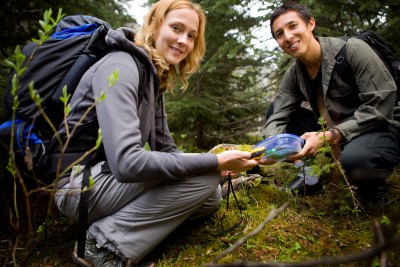There is a strange group of people who voluntarily and on their own initiative spend their time hiding weatherproof packages filled with trinkets in cities and wilderness areas all over the world. The challenge is to use a GPS system to locate the coordinates of this secret cache to find these treasures. This is geocachingand it is a perfect way to get the family out and doing something fun and unusual. It is kind of like a quest video game but where you walk around in actual nature with real people on your team! (In most locations there is a regrettable absence of ravenous carnivores, brain eating zombies or murderous thugs armed with automatic weapons who are out to kill you.)
Geocaching is a game where people hunt for containers that are hidden in plain sight (never buried or in a dangerous location). The container, or cache, has a logbook and small, inexpensive trinkets left by others who have come before. Before the near universal availability of satellite tracking, people played this game with a map and a compass. These days all you need to get started is to download an app from a site like Geocaching.com. In about 2 minutes you are ready to start your adventure. The beauty of this activity is it can be enjoyed alone or combined with other activities like picnicking, hiking or camping.
Here is what you need to get started. (This brochure provides a good summary.)
Download the app. There are several apps for this. The app and resources at Geocaching.com will give you everything you need. The more family members with the app the more chaotic and competitive things will be so get one for everyone with a cellphone.
Pick a destination. Go down the list and locate a suitable cache with the desired level of terrain and difficulty in the area you want to go searching. There may even be one within walking distance of your home. Some routes lead you directly to the cache. Other caches require you to read clues at multiple sites before you finally locate the cache.
Dress appropriately. Nothing fancy, just comfortable clothes and walking shoes. It won’t hurt to bring along water and snacks for whiny kids.
Bring something to put in the cache box. When you arrive at the cache box, you can simply jot down your info on the logbook. But it is fun (and a good lesson in politeness) to bring some trinkets to place in the cache box. You are allowed to take something others have left as long as you replace it with something you brought. Going shopping for trinkets beforehand adds another dimension to the adventure. (But, remember, nothing expensive. It’s the thought that counts.)
Be careful and considerate. Make sure you go over the rules with your kids before you embark on this quest. It is important to check your GPS coordinates but it is more important to watch where you are going. Don’t walk over a crevasse or tumble down a ravine. Stop looking at the signal when you get close to where the cache is located. Find it with your eyes. The cache is in plain sight (or nearly so). You don’t have to dig or disturb the surrounding area. Make sure you leave the area as you found it (including carrying any trash with you rather than just throwing it on the ground).
Join in the fun. After your family has given this a try consider setting up your own geocache for others to find. The arguing, planning and decision making your kids will have to go through can be an added benefit. Not to mention how you are going to construct the cache box.
And, if you are still a bit hesitant to just strike out on your own (though that would make it even MORE important to do it), more and more local organizations (like our own Warner Park) are hosting guided geocaching activity for families.
So, when you are sitting around wondering what kind of unusual family outing to undertake, geocaching can be just the thing. You may very well get addicted to this. It can be REALLY cool!
posted in www.brentwoodhomepage.com

